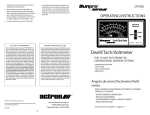Download Actron CP7605 Operating instructions
Transcript
CP7605 OPERATING INSTRUCTIONS Dwell/Tach/Voltmeter FOR 12 VOLT ELECTRONIC OR CONVENTIONAL IGNITION SYSTEMS • OPERATING INSTRUCTIONS • SAFETY RULES • TUNE-UP PROCEDURES • REPAIR PARTS SAFETY GUIDELINES TO PREVENT ACCIDENTS THAT COULD RESULT IN SERIOUS INJURY AND/OR DAMAGE TO YOUR VEHICLE OR TEST EQUIPMENT, CAREFULLY FOLLOW THESE SAFETY RULES AND TEST PROCEDURES SAFETY EQUIPMENT Fire Extinguisher Never work on your car without having a suitable fire extinguisher handy. A 5-lb or larger CO2 or dry chemical unit specified for gasoline/chemical/electrical fires is recommended. Fireproof Container Rags and flammable liquids should be stored only in fireproof, closed metal containers. A gasolinesoaked rag should be allowed to dry thoroughly outdoors before being discarded. Safety Goggles We recommend wearing safety goggles when working on your car, to protect your eyes from battery acid, gasoline, and dust and dirt flying off moving engine parts. NOTE: Never look directly into the carburetor throat while the engine is cranking or running, as sudden backfire can cause burns. LOOSE CLOTHING AND LONG HAIR (MOVING PARTS) Be very careful not to get your hands, hair or clothes near any moving parts such as fan blades, belts and pulleys or throttle and transmission linkages. Never wear neckties or loose clothing when working on your car. JEWELRY Never wear wrist watches, rings or other jewelry when working on your car. You’ll avoid the possibility of catching on moving parts or causing an electrical short circuit which could shock or burn you. VENTILATION The carbon monoxide in exhaust gas is highly toxic. To avoid asphyxiation, always operate vehicle in a well-ventilated area. If vehicle is in an enclosed area, exhaust should be routed directly to the outside via leakproof exhaust hose. SETTING THE BRAKE Make sure that your car is in Park or Neutral, and that the parking brake is firmly set. NOTE: Some vehicles have an automatic release on the parking brake when the gear shift lever is removed from the PARK position. This feature must be disabled when it is necessary (for testing) to have the parking brake engaged when in the DRIVE position. Refer to your vehicle service manual for more information. HOT SURFACES Avoid contact with hot surfaces such as exhaust manifolds and pipes, mufflers (catalytic converters), radiator and hoses. Never remove the radiator cap while the engine is hot, as escaping coolant under pressure may seriously burn you. SMOKING AND OPEN FLAMES Never smoke while working on your car. Gasoline vapor is highly flammable, and the gas formed in a charging battery is explosive. BATTERY Do not lay tools or equipment on the battery. Accidentally grounding the“HOT”battery terminal can shock or burn you and damage wiring, the battery or your tools and testers. Be careful of contact with battery acid. It can burn holes in your clothing and burn your skin or eyes. When operating any test instrument from an auxiliary battery, connect a jumper wire between the negative terminal of the auxiliary battery and ground on the vehicle under test. When working in a garage or other enclosed area, auxiliary battery should be located at least 18 inches above the floor to minimize the possibility of igniting gasoline vapors HIGH VOLTAGE High voltage — 30,000 to 50,000 volts — is present in the ignition coil, distributor cap, ignition wires and spark plugs. When handling ignition wires while the engine is running, use insulated pliers to avoid a shock. While not lethal, a shock may cause you to jerk involuntarily and hurt yourself. JACK The jack supplied with the vehicle should be used only for changing wheels. Never crawl under car or run engine while vehicle is on a jack. IMPORTANT THIS MANUAL PRESENTS COMPLETE HOOKUP INSTRUCTIONS FOR THE DWELL/TACH/VOLTMETER, IT ALSO DESCRIBES MANY OF THE TESTS THAT THIS INSTRUMENT IS CAPABLE OF PERFORMING AS WELL AS WHEN THEY SHOULD BE USED BASED ON VEHICLE PERFORMANCE, TUNE-UP OR TROUBLE ENCOUNTERED. CONSULT YOUR VEHICLE SERVICE MANUAL FOR SPECIFIC TUNE-UP INFORMATION AND TEST PROCEDURES. ALWAYS FOLLOW THE MANUFACTURER’S SPECIFICATIONS AND TEST PROCEDURES FOR ADJUSTING DWELL ANGLE AND IDLE SPEED, ESPECIALLY ON VEHICLES WITH MODERN ELECTRONIC IGNITION AND EMISSION CONTROLS. DO NOT ATTEMPT TO SERVICE A VEHICLE WITHOUT THE MANUFACTURER’S INSTRUCTIONS AND SPECIFICATIONS. ACCESSORIES FUNCTIONS, CONNECTIONS AND ACCESSORIES Fig. 3 See Figure 2. of the instrument. DESCRIPTION The Model CP7605 Dwell/Tach/Voltmeter has a clearly labeled function switch and meter as shown in the Master Hookup diagram, Figure 1 below. 1. METER This meter displays the following scales: • Volts 0-16 • RPM 0-2000 (8 cylinder) 0-4000(4cylinder – multiply 3. TEST LEAD Hook this lead to the proper test point in the vehicle to perform tests as required and as described below: VOLTAGE MEASUREMENTS GREEN CLIP – Connect to the Positive (+) voltage source to be measured. (+ Battery terminal, alternator output terminal, lamp socket, etc.). BLACK CLIP – Vehicle ground. CAUTION! 8 cylinder scale by 2) • RPM 0-2500 (6 cylinder) • Dwell 0-45 degrees (8 cylinder) 0-90 degrees (4 Avoid connecting the BLACK CLIP to the negative(-) battery terminal or any fuel system components in the event that glasses are present which could explode from sparking connections. cylinder– multiply 8 cylinder by 2) • Dwell 0-60 degrees (6 cylinder) • Points OK/Defective DWELL/TACH/BREAKER POINT RESISTANCE MEASUREMENT GREEN CLIP – Connect to the Tach or negative (-) ignition coil terminal. See Figures 3 through 10 for specific applications 2. FUNCTION SELECTOR This selects the RPM, Dwell, or Volts functions BLACK CLIP – Vehicle Ground. See CAUTION under voltage measurements. 1. GM DIAGNOSTIC ADAPTOR The GM Diagnostic Adaptor is used to make connection to vehicle equipped with the GM Diagnostic Connector, (1976 –1982). It is also used to make connection to Toyota vehicles which use the IIA (Integrated Ignition Assembly). See Figures 9 and 10 for adaptor application. TO BALLAST GREEN CLIP (BAT.) CONTROL UNIT 2. GM HEI ADAPTOR The GM HEI Adaptor is used to provide connection to the “TACH” terminal on GM HEI systems. See Figure 7 for typical installation. 3. FORD COIL CLIP The Ford Coil Clip is used for ignition systems which have booted ignition coil connections. See Figure 4 for clip application. TO CONTROL UNIT COIL All Chrysler Corporation Electronic Ignitions, 6 & 8 cylinder shown 1972 - 1986 Fig. 4 ELECTRICAL SYSTEM TESTS – "VOLTS" POSITION Fig. 2 Primary Tach/Dwell Connection – GREEN Clip TO IGNITION SWITCH Accessories 3 TO DIST. FORD ADAPTER GREEN CLIP 1 Fig. 1 Master Hookup Diagram Primary Tach Connection — GREEN Clip 2 1974 Ford Electronic and All Breaker Points Ignition Systems Fig. 5 BLACK ENGINE GROUND Primary Tach Connection — GREEN Clip GREEN CLIP DIST. OR TACH GREEN BAT. DISTRIBUTOR COIL Ford Solid State & Dura Spark systems 1975 - 1986 Fig. 6 Fig. 9 Primary Tach Connection — GREEN Clip Primary Tach Connection — GREEN Clip 2. BLACK CLIP – Connect to Vehicle Ground. SPADE TERMINAL ADAPTER GREEN CLIP GREEN CLIP BASIC SYSTEM CHECK – Charging Voltage 1. GREEN CLIP – Connect to the Positive (+) Battery terminal. 3. FUNCTION SELECTOR – Volts 4. Start engine and allow it to warm up completely. Operate it at curb idle. 5. With all accessories off observe the 16 volt scale on the analyzer. 6. Normal Result – 13.2 to 15.2 volts or as specified in the vehicle service manual. 7. FUNCTION SELECTOR – RPM GM Diagnostic Connector and Delco HEI Systems 1976 - 1982 Ford TFI Systems 1981 - 1986 Fig. 7 Fig. 10 Primary Tach Connection — GREEN Clip Primary Tach Connection — GREEN Clip TO IGNITION SWITCH INSERT DIAGNOSTIC ADAPTER GREEN CLIP REMOVE CAP FROM TACH TEST CONNECTOR GREEN CLIP ADAPTER Toyota IIA (Integrated Ignition Assembly) 1983 - 1986 Delco HEI 1974 - 1986 Integral Coil 8. Select a step on the fast idle cam which will maintain engine speed between l800 and 2000 RPM (or have an assistant hold engine speed in this range) through Step 12. Fig. 11 Primary Tach Connection — GREEN Clip Performance Check ONLY Note: This is NOT a Tach Connection point. DWELL CONNECTOR (GREEN) NOTE: The voltmeter function of this instrument can be used anywhere the vehicle service manual calls for voltage measurement except in those applications which call for 10 Megohm input impedance or a digital voltmeter. 10. Observe the 16 volt scale on the analyzer. The voltage should not have changed from Step 6 more than about .5 volts. IGNITION SYSTEM TEST – "VOLTS" POSITION 11. Load the electrical system by turning on the lights, Hi fan, and wipers. BREAKER POINT RESISTANCE TEST (Breaker Point Systems Only) 12. Observe the 16 volt scale on the analyzer. The voltage should not drop below about 13.0 volts. 1. Visually check the breaker points and associated wiring and connections. Check to see that the lead from the distributor to the Negative (-) terminal of the ignition coil is not damaged (nicked insulation, etc.) 13. Shut off all accessories, return the engine to curb idle, and shut it off. If the results obtained in Step 6, 10 or 12 are significantly different from those shown or from the vehicle service manual values, further diagnosis is required: see your vehicle service manual. If the engine cranks slowly or not at all, the battery, cranking motor, and associated wiring may be at fault. Check the cranking voltage as indicated below. 1. Connect the analyzer to the vehicle battery as shown in Figure 1. 2. Disable the engine from starting as shown in Figure 12 or as explained in your vehicle service manual GREEN CLIP MISCELLANEOUS VOLTAGE TESTS This instrument can perform many of the voltage tests called out in the vehicle service manual, such as voltages at lamp sockets, motors, solenoids and relays. 9. FUNCTION SELECTOR – Volts CRANKING VOLTAGE AND BATTERY CONDITION Fig. 8 diagnosis. 7. If battery voltage remains abnormally high (above approximately 10.5 volts) on a slow or no cranking engine, the problem may be loose or corroded connection(s) in the cranking circuit. 2. Remove the distributor cap and inspect the breaker points. Properly adjusted breaker points become light gray in color in normal use. If they are blued, blackened or pitted, they have exceeded their normal life. 3. To prevent the engine from starting, disable the ignition system by grounding the coil tower wire as shown in Figure 12. 4. Connect the GREEN and BLACK clips as de- Fig. 12 Disabling Procedure Breaker Point Ignition System 3. FUNCTION SELECTOR – Volts GREEN CLIP or Ground Jumper – See Vehicle Service Manual Delco HEI 1974 - 1986 External Coil GM C3 (Computer Command Control) 4. Crank the engine while observing the 16 volt scale on the analyzer. 5. Normal Result – 9.6 volts or more at 70°F. Voltage will drop slightly as temperature decreases. 6. If the results are significantly out of specification consult your vehicle service manual for further ENGINE GROUND scribed under DWELL/TACH/BREAKER POINT RESISTANCE MEASUREMENTS Start the engine and allow it to warm up (upper radiator hose hot.) NOTE: When testing a vehicle with dual points, alternately block one set of points open with a piece of insulating material while the other set is being tested. Operate the engine at curb idle OR the RPM specified by the vehicle emission control label or the vehicle service manual for measuring dwell. 5. Turn the ignition key ON. If the meter reads voltage, (12.5 - 13.0) the points are OPEN. Crank the engine a fraction of a revolution at a time until the meter reads in the left hand area of the scale. Check the RPM by switching the FUNCTION SELECTOR TO RPM and reading the appropriate meter scale. Return the FUNCTION SELECTOR to DWELL and observe the correct dwell scale The points are now closed. Test Results: Normal – Meter reads in the OK zone of the Points scale. The Analyzer may indicate high point resistance on a new set of points until they have been run in the vehicle for a few miles and have been properly seated. This condition may be ignored as long as any defects discovered during the previous visual check have been corrected. Abnormal – If the meter indicates in the Bad zone when the points are closed, the points may be defective or the following faults may exist: Poor distributor ground Poor connection on the primary lead from the distributor to the ignition coil Defective distributor pigtail lead Misaligned points Poor points/plate ground inside distributor Fig. 13 Typical General Motors Breaker Points Distributor On GM distributors with a small metal slide cover, lift the cover and insert a l/8" Allen wrench in the adjusting screw socket and adjust the dwell by turning the wrench, as shown in Figure 13. On Ford, Chrysler, American Motors, and other distributors not equipped with a small metal access slide cover, perform the following steps while referring to Figure 14. MORE THAN 3 DEGREES 1/8" ALLEN WRENCH ADJUSTMENT SCREW checking DWELL angle. Usually, the vacuum hose must be disconnected from the distributor and plugged Increase the engine speed from idle to about 1500 RPM and note the dwell angle (Figure 15). Return the engine speed to idle and again note the dwell angle. If the difference between the two dwell angle readings is more than 3 degrees, check for excessive wear in the breaker point plate and couplings or excessive wear in the distributor shaft gear and bushings. Fig. 14 IGNITION SYSTEM TEST – "DWELL" POSITION 2. Remove the distributor cap and rotor. (All, except Delco-Remy Sliding Window Distributors) DWELL TEST AND ADJUSTMENT – Breaker Point Systems Only or Transistorized Systems which Use Breaker Points. 4. With ignition switch ON and engine cranking observe reading on the Dwell scale. 1. Preparation: Before performing the DWELL TEST AND ADJUSTMENT PROCEDURE, read the vehicle emission control label or the vehicle service manual to determine what should be done with the vacuum hoses connected to the distributor and the various advance/retard solenoids. Most often, the vacuum hose must be disconnected from the distributor and the end plugged with a plastic golf “tee” or other plug. Connect the GREEN and BLACK clips as described under TACH/DWELL/BREAKER POINT RESISTANCE MEASUREMENTS. 2. Test Procedure: 6. Reassemble distributor and recheck dwell reading with engine operating at idle speed. Repeat steps 5 and 6 if necessary. DWELL VARIATION TEST Read the owner’s manual or engine compartment decal and follow the instructions regarding vacuum line or advance-retard solenoid connections when ADJUSTMENT SLOTTED HOLE LOCKING SCREW BREAKER POINTS FUEL SYSTEM TESTS – "DWELL" POSITION 1. General Motors C-3 (Computer Command Control) Mixture Control Solenoid Dwell (Carburetor equipped vehicles only). The GMC-3 system controls Air/Fuel ratio with a mixture control solenoid mounted in the carburetor. The basic system performance check of this system calls for the checking of the duty cycle or dwell of the M/C solenoid. Note that regardless of the number of cylinders in the vehicle, the reading is always taken from the 6 cylinder scale. 2. This analyzer may be used to check C-3 Dwell (duty cycle). Refer to your vehicle service manual for hookup instructions and performance results. See Figure 11. Dwell Adjustment 3. Connect a remote starter switch to the vehicle or have an assistant crank the engine for you. 5. To adjust Dwell, loosen the locking screw slightly and adjust the point gap with a feeler gauge according to the procedure outlined in the vehicle service manual. After adjustment, tighten locking screw, and recheck dwell while cranking engine. Repeat procedure if necessary. (Figure 14.) SECOND READING WINDOW 1. Remove coil wire from center tower of distributor cap and ground the wire by connecting the loose end to the engine or frame, See Figure 12. Correct the defect and repeat the test. Dwell Variation FIRST READING NOTE: There is a direct relationship between dwell and timing. However, it is only a one way relationship. If you change the dwell angle of the breaker points, you will automatically change the ignition timing. Changing the timing, though, has no effect on the dwell angle. FOR THIS REASON, IT IS IMPORTANT TO RE-CHECK THE TIMING WHEN EVER THE DWELL ANGLE HAS BEEN ADJUSTED. DWELL ADJUSTMENT – Conventional Breaker Point Systems Fig. 15 BREAKER POINTS ADJUSTMENT SCREW ENGINE TESTS – "RPM" POSITION 1. Carburetor Adjustments – There are several adjustments which should be checked as part of a performance tune-up. Those which require engine RPM monitoring are: a. Curb idle b. Base idle c. Solenoid Controlled idle d. Fast idle Your vehicle will likely have some combination of these adjustments. Proper adjustment of these settings is a requirement for good engine performance and driveability. 2. Fuel Injection Adjustments – Some fuel injection systems have a minimum and maximum authority adjustment which should be checked during routine performance tune-up or whenever idle problems are encountered. 3. Miscellaneous Engine Test – Many of the test procedures in your vehicle service manual require the engine to run at a specific RPM during the test. Your instrument provides excellent monitoring capabilities for this purpose. Model CP7605 Replacement Parts Key No. Part No. 1 2 3 4 5 6 7 8 9 — 400-857 270-117 38-726 450-133 180-300 38-1342 1-1086 1-1085 400-855 2-219301 Description Case, bottom Screw, Case self-tap. #6-20 x 1" Cable Assembly, Green and Black Clip Cap, Glamour Ford Adapter GM Adapter Switch Decal Meter Decal Window Instruction Manual (Not shown) NOTE: The circuit board and meter are not replacement parts since the replacement of either requires recalibration of the instrument. ACTRON HAND TOOLS















